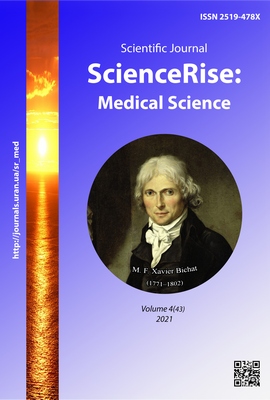Trauma-induced coagulopathy: prospective observation study
DOI:
https://doi.org/10.15587/2519-4798.2021.238094Keywords:
coagulopathy, polytrauma, coagulation hemostasis, vascular-platelet hemostasis, hypocoagulation, platelets, tranexamic acidAbstract
Coagulopathy remains the leading cause of illness and death in people with severe trauma.
The aim was to study the indicators of vascular-platelet hemostasis in severe trauma and to establish changes in the main pathophysiological mechanisms of primary hemostasis that occur in patients with trauma-induced coagulopathy, compared with almost healthy individuals of the same age.
Materials and methods. The study included 44 patients aged 19 to 55 years (36.1 [28.7; 43.2] years). The control group included 20 patients of the therapeutic department without preconditions for changes in the hemostasis system, and the main group - 24 patients with diagnosis of “severe trauma” who were treated in the anesthesiology and intensive care department.
Results and discussion. We studied indicators of intravascular platelet activation. Patients had a normal number of platelets in the venous blood, but the level of spherocytes and spheroechinocytes increased. On the 3rd day after the injury, number of platelets in the venous blood was normal, however the level of discocytes decreased, and the level of discochinocytes, spheroechinocytes and the sum of active forms of platelets increased. On the fifth day, the level of discochinocytes and active forms of platelets, significantly higher (p<0.05) among patients of the main group, and spherocytes, spheroechinocytes and platelets involved in the aggregates, were significantly lower than in the control group of patients (p<0.05).
Conclusions. Indicators of vascular-platelet hemostasis in patients with polytrauma had significant differences from those of the control group. This may be evidence of activation of the vascular-platelet system of the hemostasis system and may be a prerequisite for late thrombotic complications in patients with polytrauma
References
- Kornblith, L. Z., Moore, H. B., Cohen, M. J. (2019). Trauma‐induced coagulopathy: The past, present, and future. Journal of Thrombosis and Haemostasis, 17 (6), 852–862. doi: http://doi.org/10.1111/jth.14450
- Moore, E. E., Moore, H. B., Kornblith, L. Z., Neal, M. D., Hoffman, M., Mutch, N. J. et. al. (2021). Trauma-induced coagulopathy. Nature Reviews Disease Primers, 7 (1). doi: http://doi.org/10.1038/s41572-021-00264-3
- Cardenas, J. C., Wade, C. E., Holcomb, J. B. (2014). Mechanisms of trauma-induced coagulopathy. Current Opinion in Hematology, 21 (5), 404–409. doi: http://doi.org/10.1097/moh.0000000000000063
- Solomon, C., Traintinger, S., Ziegler, B., Hanke, A., Rahe-Meyer, N., Voelckel, W., Schöchl, H. (2011). Platelet function following trauma. Thrombosis and Haemostasis, 106 (8), 322–330. doi: http://doi.org/10.1160/th11-03-0175
- Kornblith, L. Z., Robles, A. J., Conroy, A. S., Hendrickson, C. M., Calfee, C. S., Fields, A. T. et. al. (2018). Perhaps it’s not the platelet: ristocetin uncovers the potential role of von Willebrand factor in impaired platelet aggregation following traumatic brain injury. Journal of Trauma and Acute Care Surgery, 85 (5), 873–880. doi: http://doi.org/10.1097/ta.0000000000002025
- Sirajuddin, S., Valdez, C., DePalma, L., Maluso, P., Singhal, R., Schroeder, M., Sarani, B. (2016). Inhibition of platelet function is common following even minor injury. Journal of Trauma and Acute Care Surgery, 81 (2), 328–332. doi: http://doi.org/10.1097/ta.0000000000001057
- ISTH Criteria for Disseminated Intravascular Coagulation. Available at: https://www.mdcalc.com/isth-criteria-disseminated-intravascular-coagulation-dic#why-use
- Hagemo, J. S., Stanworth, S., Juffermans, N. P., Brohi, K., Cohen, M., Johansson, P. I. et. al. (2014). Prevalence, predictors and outcome of hypofibrinogenaemia in trauma: a multicentre observational study. Critical Care, 18 (2), R52. doi: http://doi.org/10.1186/cc13798
- Kornblith, L. Z., Kutcher, M. E., Redick, B. J., Calfee, C. S., Vilardi, R. F., Cohen, M. J. (2014). Fibrinogen and platelet contributions to clot formation: implications for trauma resuscitation and thromboprophylaxis. Journal of Trauma and Acute Care Surgery, 76 (2), 255–263. doi: http://doi.org/10.1097/ta.0000000000000108
- Brown, L. M., Call, M. S., Margaret Knudson, M., Cohen, M. J. (2011). A Normal Platelet Count May Not Be Enough: The Impact of Admission Platelet Count on Mortality and Transfusion in Severely Injured Trauma Patients. Journal of Trauma: Injury, Infection & Critical Care, 71 (2), S337–S342. doi: http://doi.org/10.1097/ta.0b013e318227f67c
- Wohlauer, M. V., Moore, E. E., Thomas, S., Sauaia, A., Evans, E., Harr, J. et. al. (2012). Early Platelet Dysfunction: An Unrecognized Role in the Acute Coagulopathy of Trauma. Journal of the American College of Surgeons, 214 (5), 739–746. doi: http://doi.org/10.1016/j.jamcollsurg.2012.01.050
- Napolitano, L. M., Cohen, M. J., Cotton, B. A., Schreiber, M. A., Moore, E. E. (2013). Tranexamic acid in trauma: how should we use it. Journal of Trauma and Acute Care Surgery, 74 (6), 1575–1586. doi: http://doi.org/10.1097/ta.0b013e318292cc54
- Plautz, W. E., Matthay, Z. A., Rollins‐Raval, M. A., Raval, J. S., Kornblith, L. Z., Neal, M. D. (2020). Von Willebrand factor as a thrombotic and inflammatory mediator in critical illness. Transfusion, 60 (S3), S158–S166. doi: http://doi.org/10.1111/trf.15667
Downloads
Published
How to Cite
Issue
Section
License
Copyright (c) 2021 Mariana Vyshynska

This work is licensed under a Creative Commons Attribution 4.0 International License.
Our journal abides by the Creative Commons CC BY copyright rights and permissions for open access journals.
Authors, who are published in this journal, agree to the following conditions:
1. The authors reserve the right to authorship of the work and pass the first publication right of this work to the journal under the terms of a Creative Commons CC BY, which allows others to freely distribute the published research with the obligatory reference to the authors of the original work and the first publication of the work in this journal.
2. The authors have the right to conclude separate supplement agreements that relate to non-exclusive work distribution in the form in which it has been published by the journal (for example, to upload the work to the online storage of the journal or publish it as part of a monograph), provided that the reference to the first publication of the work in this journal is included.









